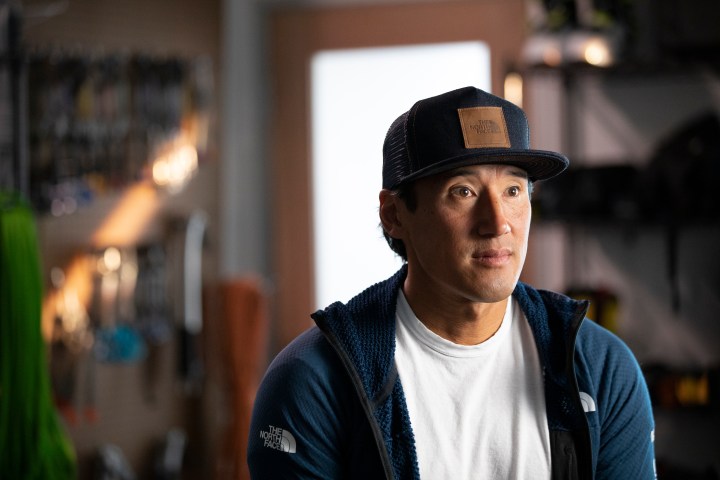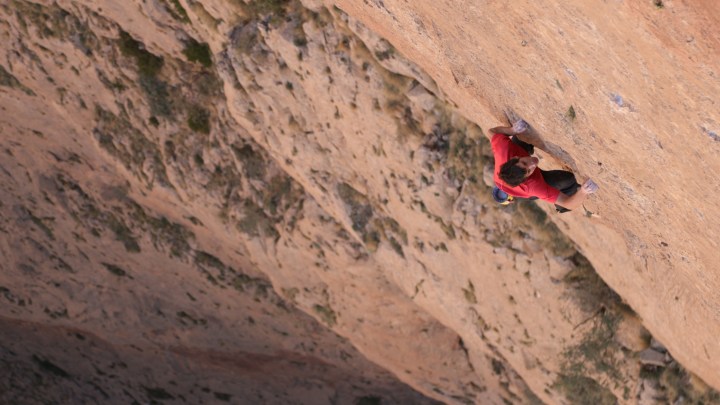Jimmy Chin is on a mission to showcase the greatest adventure athletes in the world. Through his work with brands such as The North Face and Yeti to award-winning documentaries like Free Solo and The Rescue, Chin’s projects are just as spectacular as they are dangerous. The secret to Chin’s success lies in his innate ability to humanize these athletes in such a way that the rest of the population can understand why they push themselves beyond their limits.
Chin is once again opening the door to a world where the impossible becomes possible in Edge of the Unknown with Jimmy Chin. Co-produced with his wife, E. Chai Vasarhelyi, Edge of the Unknown is an in-depth view of the world’s top adventure athletes as they recall some of the most seminal moments in their lives and the decisions behind these pursuits.
In an interview with Digital Trends, Chin speaks about his appreciation for these athletes as well as why they continue to test their limits even if it could result in death. Chin also explores Free Solo, his collaboration process with Chai, and how he abandoned a potential career at the UN for climbing at Yosemite.

Note: This interview has been condensed and edited for length and clarity.
Digital Trends: Edge of the Unknown follows some of the most acclaimed athletes in the world, but it’s also a character study about people that have put in so many years to perfect their craft and how the decisions they make affect those around them. What was the original goal behind this series?
Jimmy Chin: I think the original goal was just to give an insider’s view of what it means to be an elite professional athlete in 2022, and give audiences a deeper appreciation of who these athletes are and what they actually do. I think there are a lot of misperceptions about these outdoor adventure athletes. I wanted to give that insider view so that people could connect more with them. I think a lot of the perceptions of these incredible athletes and extraordinary athletes and people are that they’re not like them. But in reality, when you see them in these kinds of situations and the decisions that they have to make, I just really hope the audiences really connect on a different level.
All of the athletes in the series acknowledge the dangers in their respective sports. In some cases, it’s life or death. For a normal person, it’s hard to comprehend why someone would continue to push themselves this much. You’ve been on both sides of this. Why do these athletes continue to take these risks and push themselves to the unknown?
There are a lot of layers to it, and I think that’s also what we want to share in the series. For most of these athletes, this is a lifestyle for them, and these sports provide deep meaning and purpose. It’s also about the community in which they inhabit within these sports. There is also that transcendent experience that people have. Everything they have attempted to do over years and years of practice and training intersects with some huge, kind of seemingly impossible, goal. When you pull something off like that, there’s really no other kind of experience that can match it. Once you get a taste of that, it’s really hard to walk away from it.
These episodes really look at some of their most challenging moments. You know, some of the hardest, pivotal moments in their careers and how they manage [them]. We just thought that through the telling of these stories, you gain a lot of insights into who these extraordinary people are, but you also get a sense of the craft of what they do, the decision making, the risk assessment, their approach to what they do. That is the depth we wanted to give to audiences so that they could truly appreciate what they’re doing out there.
And I just think they’re great stories. I think of them as the greatest stories you’ve never heard. You can follow all these athletes and you can see all these moments. If you’re not really, truly following every single move of these athletes, you may hear one thing and another thing, and then they’ll have a moment where they do something extraordinary. They get a lot of media, and then it kind of goes away. But, the stories that really have impacted them the most you often don’t hear about, and so we wanted to tell those stories.
I find it so fascinating that these athletes know when something’s wrong and can say, “Hey, it’s just not my day. We’re not going to do it.” As a filmmaker and photographer, have you ever had to pull the plug on a project?
Yeah, all the time.
Is it a common occurrence?
Yeah, for sure, or you just don’t have the capacity to film, especially if you’re on an expedition and you’re part of the climbing team. There are endless moments I can think of where I was like, “Well, this would be extraordinary, but I need to climb or I need to deal with the ropes, or I need to put up the portaledge.” You have to carry your weight, literally, on an expedition like that.
I like this idea of the “rite of passage” in sports. If I’m an up-and-coming football player, I have to go play in the South at a big school. If I’m a surfer, I go to Pipeline. But if I’m a climber, I go to Yosemite. What makes Yosemite so special for climbers?
Certainly, the geology and the landscape, first of all. Besides being completely jaw-droppingly beautiful, the climbing there is extraordinary. It’s really accessible, kind of like Pipeline. It’s right there on the North Shore. If you want to see where you stand in the hierarchy from a historical perspective or right now, you can test yourself in Yosemite and find out pretty quickly where you stand.
But it’s also inspiring. You go there as a climber, and it’s not just a proving ground, but it’s a place to enjoy climbing and push yourself as a climber and be surrounded by really, really great climbers, which is also inspiring. It has produced not only extraordinary climbers but it’s produced a lot of really interesting people like Yvon Chouinard or Doug Tompkins or people that have gone beyond climbing and done great things.
Where do you keep your Oscar?
[Laughs] It’s in my garage.
It’s such a great achievement, and yet, I feel like everyone who wins an Oscar is like, “Oh, it’s at my other house,” or “It’s in my bathroom.”
Yeah, it’s in my garage. Someday it’ll probably move, but right now, it’s in my garage.
Personally, Free Solo is one of the greatest achievements in filmmaking. It was such an anxiety-inducing ride even if I knew Alex Honnold survives in the end. I’m like, “Can he do the karate kick at the Boulder Problem? Will he get through it?” Four years removed from the film, have you been able to take a step back and appreciate what you and your team were able to capture?
I haven’t watched it in a really, really long time. I was actually texting with Alex last night because we’re hoping to connect and go climbing pretty soon in like a couple of weeks. I don’t really spend much time thinking about it, but a lot of people definitely still come up to me pretty routinely and mention that they’ve seen Free Solo and really enjoyed it. It’s kind of mind-boggling.
I try to imagine how many people have actually seen it and who’s seen it. That, always, is interesting to me when I hear who’s seen the movie. It’s a pretty broad spectrum of people who have enjoyed the film. [Laughs] Yeah, it’s cool. It’s cool. As a filmmaker, you can only dream of and aspire to have people being moved by your work, and hopefully, inspired by the work. So I’m grateful for that, every time I hear it.
Now, you’re directing a feature film with Chai called Nyad. What has been the biggest challenge in directing a feature film?
I certainly have a much greater appreciation for what it means to direct a narrative, scripted feature. The intensity level and the number of decisions you have to make on a daily basis. The hours you’re running during production and the pressure. Budget, schedule, studio expectations, the talent, your crew. You are the captain of the ship and you got to show up every morning and steer that ship and have everybody moving in the same direction. And there are basically icebergs everywhere. [Laughs]
But in a lot of ways, I feel like my career set me up really well for that, just being on a lot of expeditions. It felt very familiar, particularly, working with talent. It’s giving great talent the space to perform at their best, which is what I spent three years doing with Alex. Trying to remove the pressure of the film and everything around him so that he could do what he did. My job was to keep it super tight, super clear, like create a runway for him.
In a lot of ways, that’s what I was doing with Annette [Bening] and Jodie [Foster]. They are extraordinary at what they do. They’re masters of their craft, and your job is really just to get the best possible performance out of them and the best possible performance out of your entire crew: DPs, wardrobe, everybody. It’s a huge team effort, and I really enjoyed it. Getting everybody moving in the same direction and getting everybody to perform at the top level. That’s how you make any sort of great work so that all felt very familiar.
You get to do this all with Chai. Is it nice having your partner beside you while doing larger-than-life tasks? Is it rewarding?
Yeah, it is. Obviously, as you might imagine, there are challenges that come with being married, having children, directing a movie, and producing a movie together. But, we bring very different things to the table, and I think we really cover each other’s blind spots in a lot of ways. We’ve been doing this long enough where it’s just very easy to say, “Oh, okay. She’s got that. I don’t have to think about it.” It gives me space to do what I need to do at a better and higher level, and she can do hers at a better and higher level when we are thinking about the different pieces of filmmaking. So that makes it really nice, and I think we’re getting better at it.

With The Rescue, it’s some of the best reenactment footage I’ve ever seen. What went behind the decision to create reenactments?
We always knew we wanted to do reenactments and we were going to make them look and feel real. Once we committed to doing reenactments and not animations, I know what I wanted it to look like and feel like. I wanted people to hold their breath in the theater. I wanted people to feel claustrophobic. I wanted people to hold their breath just like I wanted people to have their palms sweat when they’re watching Free Solo. I wanted people to squirm in their seats and feel very, very uncomfortable.
We also felt it was really important to nail it in terms of authenticity and making sure it really felt and looked real to the people who actually did it, which is why we actually brought them in and we’re like, “We’re going to shoot you doing it.” That was the kind of thought process behind it. But also keep it real and authentic and only use it if necessary to move the narrative forward. It’s always about story for us.
I read that you went from studying international relations and comparative religion to becoming this renowned climber. Why did you drop it all to go to Yosemite and climb?
There was a long time I thought I was going to go into international law. I thought I’d be working at the UN or being a diplomat of some sort or working in that realm at the United Nations. It was something that I really felt strongly about, but the calling of climbing kind of overshadowed everything. It’s one of those things where I was like, “Oh. I’ll just do it for a year.” I’m still doing it. It was one of those things where I couldn’t not do it. That was the problem. It was a pretty serious course-correct. From getting ready to try to go to Georgetown, I was pretty serious. Then I was like, “Actually, I’m going to go live in a cave at Yosemite.” [Laughs]
I think it worked out for the best if I’m being honest.
Yeah, it’s pretty good. I’m pretty happy with where I landed.
Edge of the Unknown with Jimmy Chin premieres Monday, Sept. 5, at 9:30/8:30c on National Geographic. All episodes will be available on Disney+ beginning on Wednesday, September 7



